The Aids – how they work…
One of the great classical trainers, teachers and authors of the twentieth century was Henri van Schaik. In this wonderful article which first appeared in THM in April 1987, he clearly and practically explains how to apply the aids in a horse friendly manner – and how to start a young horse without compromising its back…
The word ‘aids’ derives from to aid, to help. In French the word is ‘les aides’; in German ‘die Hilfen’; in Dutch ‘de hulpen’. Xenophon used a word with an overall meaning of ‘to indicate’.
Since I want to stress the fact that the idea of helping the horse permeates the whole literature of equitation, I need to make a short digression into history. When man made the transition from eating the horse to using him, it was to be expected that in the beginning there was fear on both sides. Man feared the horse because he was strong and unpredictable; the horse feared man because he hurt him and tried to constrain him.
I presume that once man tried to use the horse, some patient people found out that the horse is not an aggressive animal, but that he can become aggressive when constrained and treated in a cruel way. Perhaps this was the beginning of psychological insight.
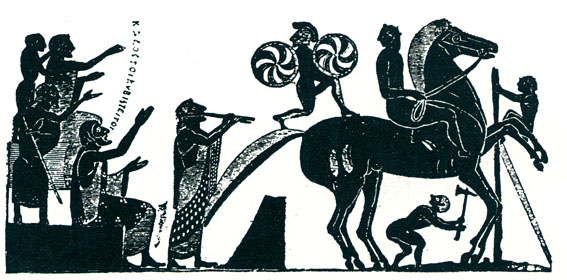
By Xenophon’s time (380 B C) a lot of progress had been made in achieving a more balanced relationship between man and horse, changing from antagonism to cooperation. Xenophon makes this clear: “One should never lose one’s temper in treating the horse; this is the one best precept and custom in dealing with horses.Those who compel the horse with blows make him more frightened than ever.”
There were, and are to this day, frequent lapses. Federigo Grisone in his Gli Ordini di Cavalcare (1550), does not forget to reward and can be very gentle. However he believes that there are vicious horses, he can also be very cruel: he advocates hitting the horse around the ears, letting a cat, tied with its back up against a pole, crawl over the belly and between the hindlegs of the horse. When a horse does not want to move forward Grisone holds burning straw under its tail.
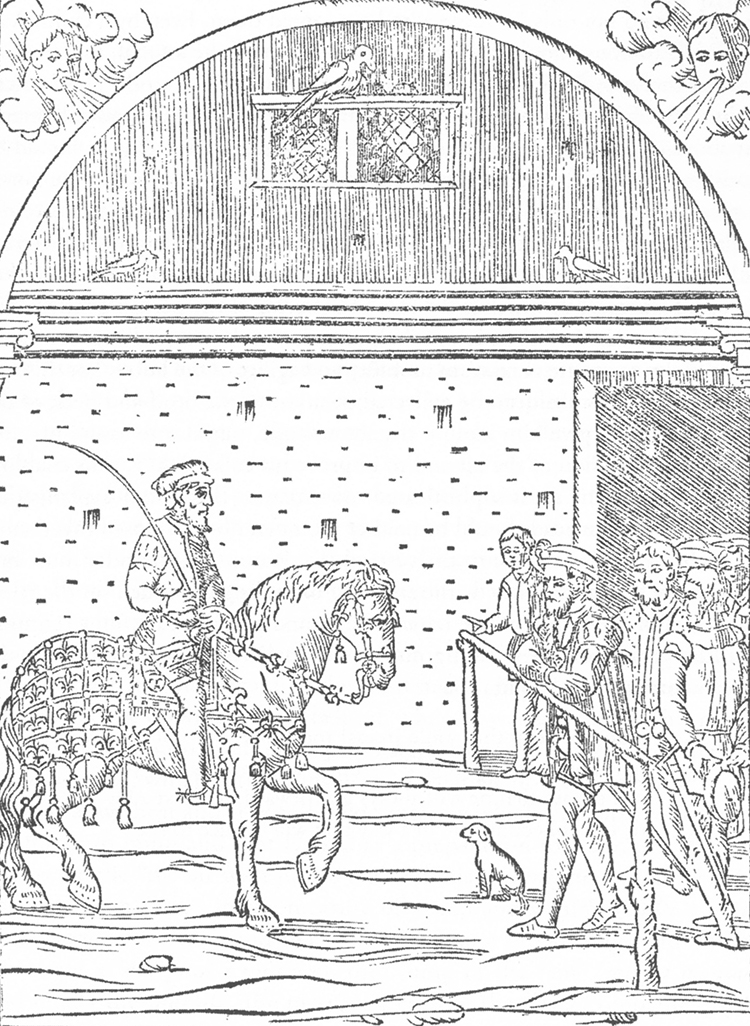
To this day there are still those who consider the horse to be the opponent. They claim that if the horse does not offer a fight, the rider should provoke one so that the horse knows who is boss. They do not seem to realise that if the horse wins the fight, they have lost the horse; if they win the fight, they have a mechanised, cowed horse without brilliance.
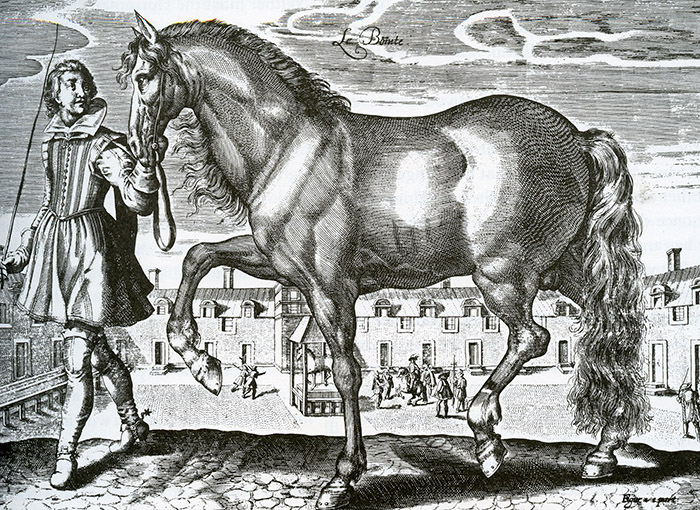
In this vein we may learn something from de Pluvinel, who wrote ‘you must be careful not to bore him or snuff out his gentleness. Because, as with the bloom on fruit, so with horses, once it is lost, it is gone forever and once the gentleness is lost, one can never regain it.’
De Pluvinel goes on to say that when one has no consideration for one’s horse, one either loses the horse’s gentleness or makes him incorrectably vicious.
De Pluvinel was not the only one to understand that it makes no sense to wage battle with the horse. Long before him, Abou Bekr, master of horse of Sultan Nacer of Egypt, around 1300 said: “Schooling is based on gentleness and psychology and should aim at developing useful qualities by making use of the qualities the horse is born with.”
Salomon de la Broue, a contemporary of de Pluvinel, wrote in Le Cavalerice françois (1504): “If a horse refuses or holds back this is not so much caused by malice, as well as by the fear of being punished, not knowing for what cause.” In the same book he wrote: “I claim that there will be disorder, resulting· in a stiff back, a hard mouth and fear and sooner or later he’ll become rebellious, if one tries to put his head and neck in the correct position, before the horse has learned to freely turn.”
As one delves into the history of equitation, two things become clear. On the one hand a lot of progress has been made in man’s attitude towards the horse and there is a lot more co-operation than antagonism. Also, techniques of how to make ·clear to the horse what we want him to do have been considerably refined. On the other hand, however, it is clear that either because of the mentality of some people, or through lack of understanding in how to deal with the horse, a lot of aggressive practices, such as mentioned in the above quotations, still continue.
After this historical intermezzo, let’s return to the subject, the aids.
When one looks at any group of riders, it is very clear that the gravest sins are committed with the hands. The main reasons for this are the natural reactions. Everybody will tell you that you have to have light and elastic contact, and that you should never pull. But practically nobody has elastic contact, and most people pull. It is appalling to see how many people ride with stretched elbows, their hands halfway up the horse’s neck, making it impossible for the horse to move freely and without constraint. Especially in the beginning of a lesson one should give the horse enough room so that he can move without being constrained.
I am convinced that practically all of the problems with a horse’s head are caused by bad hands. It is very difficult to decide when resisting becomes pulling. For this one has to understand the function of the arm muscles. In books written during the heyday of military riding, one reads that the hands should be at a certain height and that the elbows should be rigid against the body. Before the First World War, instruction was practically always given on schooled horses, who carried themselves. In such circumstances, a play of the fingers and a little movement of the wrist was all that was needed to guide the horse. But those horses are not available for instruction nowadays.
It is very important that the rider does not constrain the horse; in other words that he does not impede the forward movement of the horse. Therefore, sitting in the functionally correct position the rider should follow, in the walk, the movement of the horse’s head. He should surrender his hands to the horse, maintaining a feather-light contact with the horse’s mouth. In this way the rider will get the feel of the horse’s rhythm.
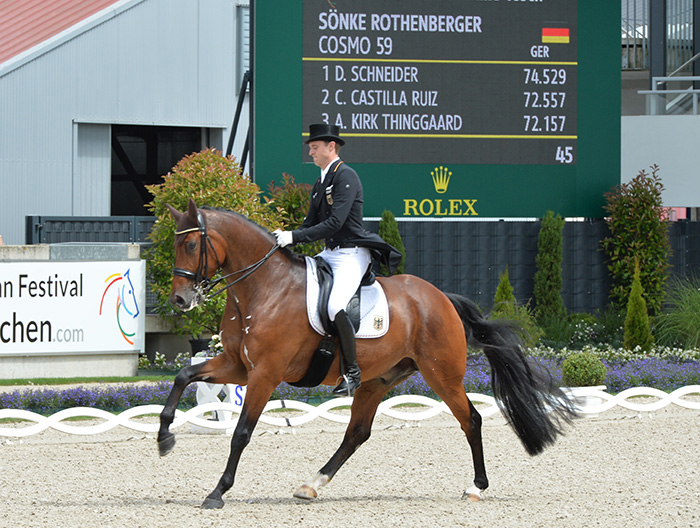
The hands should stay in a line that includes the elbow, lower arm, hand, rein and the horse’s mouth. If the hands come above that line, the horse will come behind the bit; if the hands come below that line, the head will go up. The wrist should be straight and unbroken. Only well schooled horses who have learned to carry themselves can be ridden with the wrist and fingers.
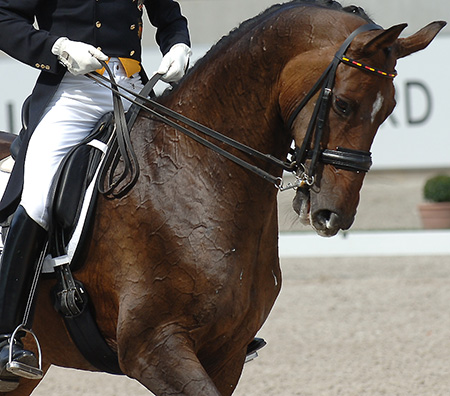
When the rider wants to restrain the horse, he should make it more difficult for the horse to bring his head forward by tightening the elastic contact, not by using the biceps, which I call ‘putting on the handbrake’. If the rider uses the biceps, he locks the elbow joint, making elasticity impossible and resulting in a hand that is not able to yield.
Also, the rider should never use the muscles in his lower arms. This is very important in order to avoid dancing hands in the trot. The hands have to be balanced, moved only by the horse and not by the rider’s body movement. When the muscles of the lower arm are contracted, it is impossible to balance the hands. Remember what the lower arm does when you try to balance a stick on your index finger.
If the rider cannot use the muscles of his lower arm, nor his biceps, what does he do to restrain the horse by putting more weight on the reins? The answer is he must use his abdominal and back muscles, his triceps and pectoralis major, the muscles one uses when one expands the rib cage when taking a deep breath. It is evident that one can do this only from the independent, balanced seat.
There was a time when it was said that a rider had to use his back in order to ride correctly, in order to influence the horse in the most efficient way. This has caused a lot of misunderstanding.
People thought that this meant that the rider had to lean backward in order to get the seat deeper into the saddle, that the rider had to make himself heavy. These are disastrous presumptions. How can one expect the horse to function well if the rider sits too heavily and does not align his own centre of gravity with that of the horse?
The less one is a burden for the horse, the better he can serve us. Riding with the back means that by using the abdominal muscles and thereby stretching the spine one creates impulsion, and by using the back muscles in combination with the triceps once can increase and decrease the weight on the reins.
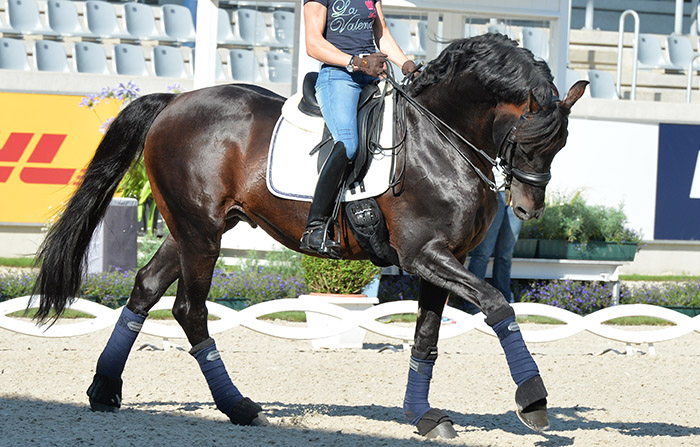
In discussing the natural reactions, I pointed to the adverse possibilities when, in making a turn, the rider pulls on the inside rein, or in other words,when he uses the direct rein of opposition. This example was the pragmatic reason never to use this rein.
In schooling horses, one should be well aware of the fact that when being ridden most horses try not to use their backs. There are various theories as to why this is. It is my conviction that this stiffness is man made.
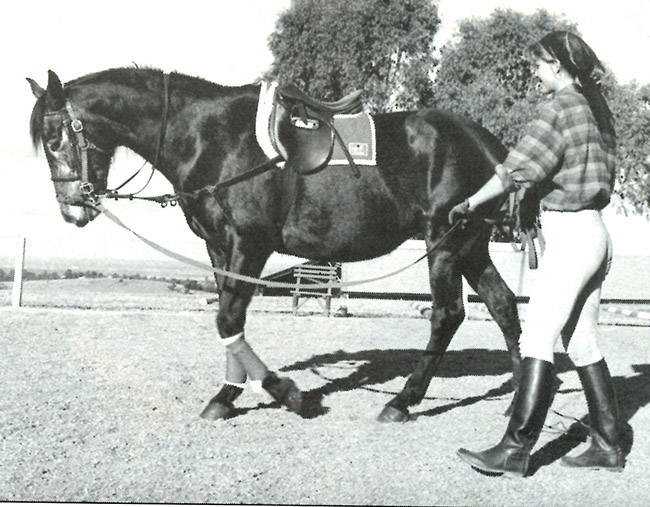
In the wild, or for that matter in pasture, one will see young unspoiled horses move with a totally decontracted body. Therefore, before putting any weight on then horse’s back, first the back muscles must be developed by gymnastic exercises so that he can cope with a burden on his back. The simplest way to do this is by lunging the horse. Then after a few months gradually let the horse get used to having a weight on his back by putting a saddle on. Then lunge with the stirrups down. After a few weeks a person can hang over the saddle and a few days later can bring the right leg over to the other side and ease into the saddle, making himself as light as possible.
While all this takes place, the horse should of course still be on the lunge line, the person who has regularly lunged the horse holding the line and making much of him. If, after all this, the horse still tightens his back when being ridden, one should repeat the exercises discussed above.
It is very important that a young horse learns to make correct changes of direction, because this is the way to teach him to use his back; an inexperienced rider can do a lot of harm to the horse by misusing the hands in the turns. The way to teach a totally untrained horse to change direction is to use the opening rein. The inside arm has to be stretched as far as possible to the inside, and the fingernails have to face upwards so that there is no downward pressure of the snaffle on the bars of the horse’s jaw.
In the beginning the outside hand should be totally passive. The action of the inside hand brings the head in, while the inside leg, with the toes up so that the calf muscle is hard, presses just behind the girth, thereby activating the inner hindleg.
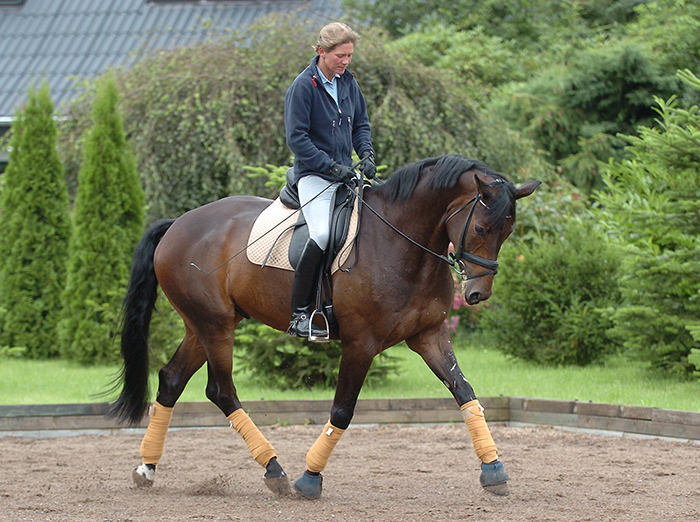
As soon as the horse has understood that he has to make a turn, the outside hand, a little higher than the inside, pushes the outside rein against, but never over the neck. When the outside hand goes over the neck, it will pull the head to the outside. That outside rein has to be taut enough so that it can function more or less like a stick. In this way the horse learns to move the shoulders inward on the pressure of the outside rein, the indirect rein.
When the horse does not need the help of the opening rein any more, then the time has come to teach him the correct way to make a change of direction, namely by bending round the rider’s inside leg and by a slight flexing of the poll, caused by a light vibration of the rider’s inside hand,so that the rider can just see the shimmer of the inside eye.
A way to find out if the horse has understood the meaning of the indirect rein is to turn right, using the right opening rein, then to turn left with that same rein, now as indirect rein against the neck. The inside rein has now to be used to get the horse to flex so that the rider can see the shimmer of the inside eye. Consequently, the horse will look in the direction he is going, and eventually he will yield to the rider’s hand, by flexing the poll and letting go in the jaw.
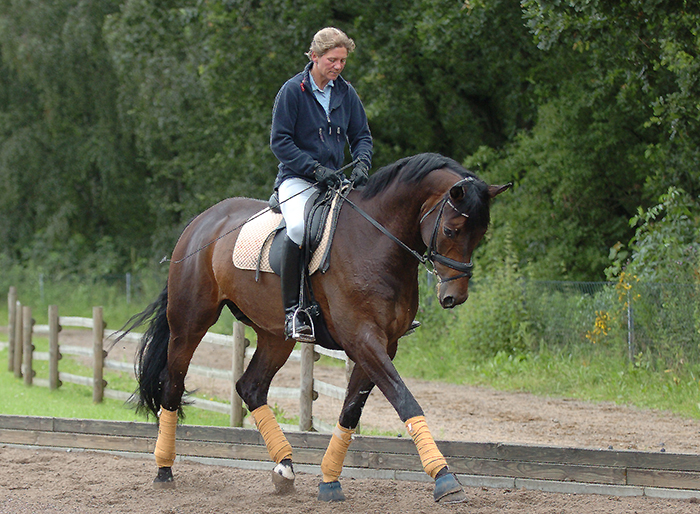
The inside rein should be taut enough so that the vibration of the rider’s hand can come through to the horse’s mouth. Sometimes a gentle upward rotation of the hand is enough to get the flexion. The rider’s hand should stay close to the withers, to prevent the head from coming in. By supporting the horse with the outside rein, pressing it against the neck to ask for a change of direction, and using the inside rein only to see the shimmer of the eye, the rider will not impede the inner hindleg from making a large stride, which he would do if he pulled on that rein.
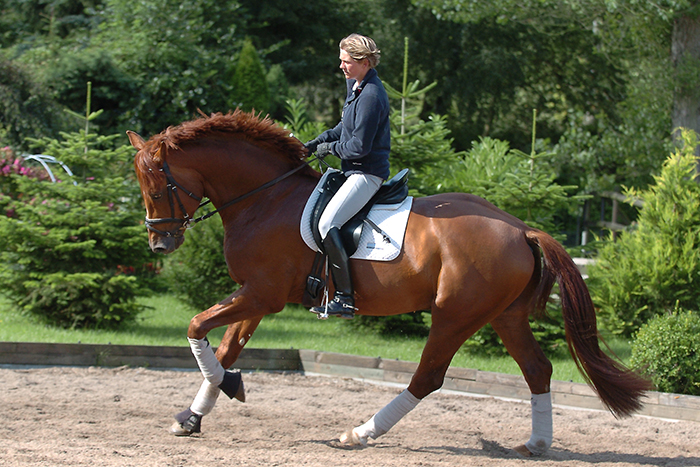
The goal is to have the horse make a large stride with the inside hindleg because this effort will gymnastically develop the back muscles. Later we will discuss what the rider’s legs are supposed to do during a change of direction. The turn to the left is generally the most difficult. This is caused by the fact that most horses have a natural bend to the right side which causes the head to be carried slightly to the right. The result is that the horse takes the left rein and does not accept the right rein. There are several explanations for this phenomenon. I think the most logical explanation is that there is no such thing as symmetry is nature. Human beings are right and left handed; some horses take the right rein, most take the left. The result of this taking of the left rein is that, in a turn the horse will shorten the stride of the inner hindleg and fall over the left shoulder.
more follows
This should make it clear how important it is to get the horse to make a correct turn, because in this way he will be able to gymnasticise the back muscles. But how difficult this is! D’Auvergne (1729-98) wrote: “it is the never ending problem for every rider with every horse to get him to go evenly on both reins.” What we ask the horse is as difficult as if we were asked to use our right and left hand in the same way. There is a difference because of the method and the goal.
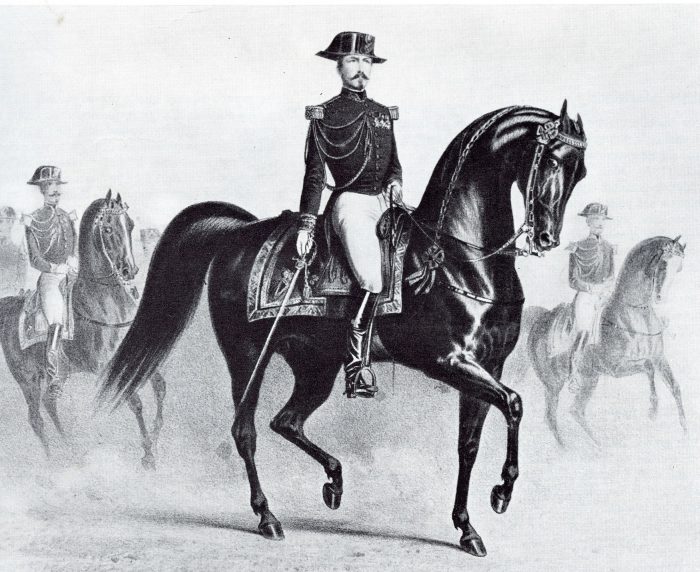
“Ideally the actions of the legs and the hands should be so discreet that the eye cannot catch them.” (l’Hotte)
Before we can reach this goal we have to manipulate, we have to do things with the hands that are visible. This is the method. However, we should always bear in mind that the less we do, the better. Since the mouth of the horse is very sensitive, we should try never to hurt it. Hard, insensitive mouths are man made.
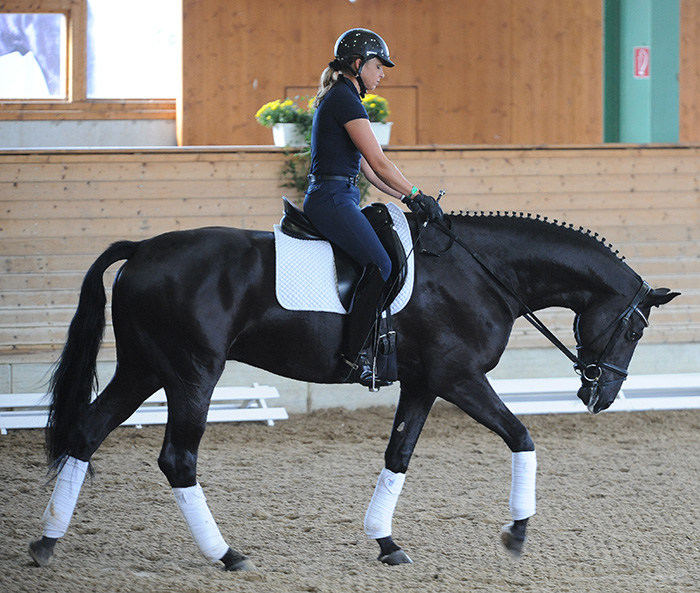
In the walk the horse makes a snake-like movement from side to side; if this movement is allowed to go through to the hands, they will make a sawing movement, alternating left and right. Many horses go better when the rider carries the reins in one hand. For this reason,when riding with two hands, the rider should keep them so still and so close together that the horse has the impression that only one hand is holding the reins. The easiest way to achieve this is to put the nails and the knuckles of the thumbs together.
One has to consider what happens when the rider makes these sawing movements when he is using a curb bit. It is easy to understand that an unbroken bit makes much more movement in the horse’s mouth than the snaffle when the rider has sawing hands. For this reason it is a very bad habit to carry the reins of an unbroken bit in two hands. How can the rider expect the horse to have confidence in his hands when this piece of solid metal is constantly moving in his mouth? Therefore, I believe that one should never carry the curb reins in two hands.
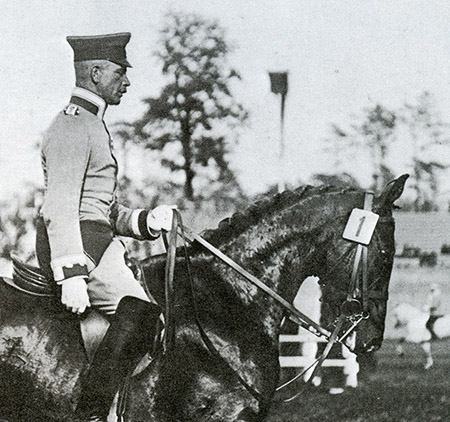
Felix Burkner riding Romeo in 1912
It is a kind of mental laziness in modem man to think that because it is easy, there is nothing wrong when one pulls right and left all the time. An example, mentioned previously, is the action of riding a bicycle when making turns. When man first began to ride he had the reins in one hand, for the simple reason that he had only one hand available; with the other hand he carried his weapons, either for hunting or for fighting.
For example, the Huns attacked without reins in their hands. They went at the enemy in waves, shooting one arrow when they were close enough; then they turned and while turning shot their second arrow; then while galloping away to make room for the next wave they shot their third arrow. To this day, the cowboy and the mounted bullfighter ride with one hand. The riders of the Spanish Riding School and a few classicists ride with the double bridle with the two curb reins in the left hand along with the left snaffle rein, and the right snaffle rein alone in the right hand.
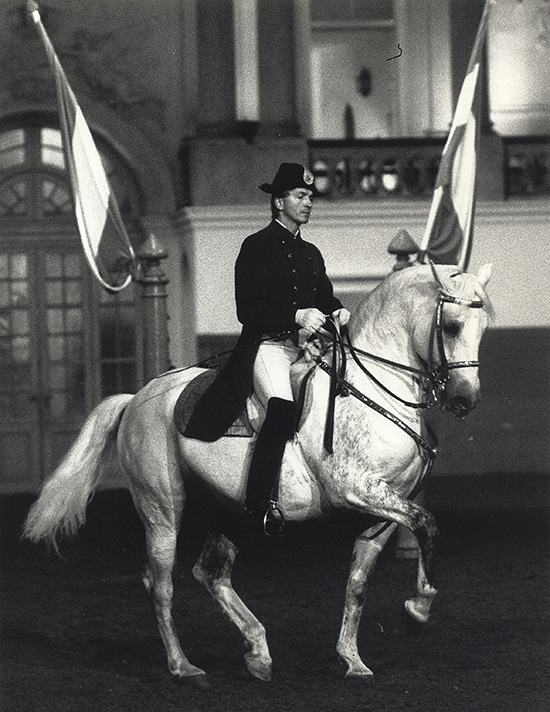
From the basic position with hands level, the thumbs on a forty five degree angle so that the back of the hands look like a slanting roof, the rider manipulates the reins while they are in one line: elbows, fists, mouth. When asking for a turn, the outside hand goes a little higher so that the rein presses against the neck.
In transitions to a slower gait, it is often helpful to turn the nails of one hand up, and sometimes even the whole hand. The reason for this is that the snaffle, being a jointed bit, will act like a nutcracker when the rider resists with level hands, the horse’s jaw will be pinched. This pinching of course hurts the horse and he will react most of the time by tossing his head up or by fighting the rider’s hand.
Now I am going to focus my attention of the impulse creating aids, the seat and the legs, which sometimes can also function as guiding aids. We have seen why it is important to have a correct position in order to apply the aids. Unfortunately the wrong translation of a German expression has caused a lot of misconceptions about what one should do when one wants the horse to go forward, when one wants to create impulsion. The Germans use the expression ‘das Kreuz anziehen’. This has been translated as ‘brace the backbone’. As a result, people thought that the idea was to round the small of the back by collapsing in the abdomen and by being heavy in the saddle. This causes the knees to go up; consequently, the calves lose muscle tone, resulting in jiggling legs.
The combination of the loose lower legs and the pulled-up heels causes the rider to poke his heels constantly into the horse’s belly; it also causes the upper body to be all over the saddle and to interfere with the horse’s balance, because the rider will not have a consistent centre of gravity.
‘To brace’ means ‘fasten against, to increase tension’. In this context ‘anziehen’ means ‘to tighten’. The backbone is the lower pan of the spinal column; the small of the back is ‘das Kreuz’. We have mentioned previously that when the muscles in the small of the back, as well as the abdominal muscles are tightened, the lordosis straightens. One can only straighten the small of the back when one makes oneself tall by using the abdominal muscles. The result of all this is that the pelvis tilts forward and upward, so that the backside of the seat bones pushes into the saddle (this is why there should be two impressions in a privately used saddle): the tone of the calf muscles increases, causing the lower legs to lie still against the horse’s belly.
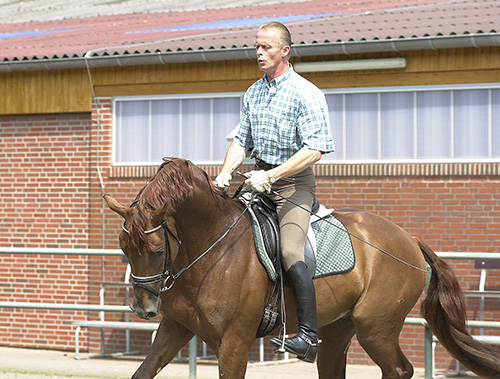
It is evident that the stretching of the spine can only be done by the abdominal muscles and back muscles, which makes it clear that the rider not only uses these muscles for the guiding aids but also for the impulse creating aids. When necessary, the driving of the seat can be strengthened by the closing of the calves. When the toes are pulled up, the calf muscles harden and a lot of pressure can be applied.
more follows the advertisement
Breeding dressage horses in Australia? Go to www.ihb.com.au and select a top European stallion like Franklin
Everybody who lunges knows how fast the horse learns the meaning of different sounds. Why not take advantage of this, and in the beginning of schooling under saddle get the horse to walk, trot and canter on voice command? The voice can have a calming effect on the horse. Therefore, I think that outside the dressage arena there should be a lot of talking. The words are not important, but the tone is. My advice is: first speak, then whisper, and finally think. This way nobody will hear you. One can hardly call clicking of the tongue a voice command, but it does encourage the horse.
In east Europe the sound produced by the vibrating tongue is a command for a down transition. I learned this in Munchen-Riem where I heard Ottokar Pohlman, an East Prussian, making this sound. When I later tried this with my Polish Trakehner, who had been in America for several years, I found to my amazement that the horse recognized the sound and responded to it. ·
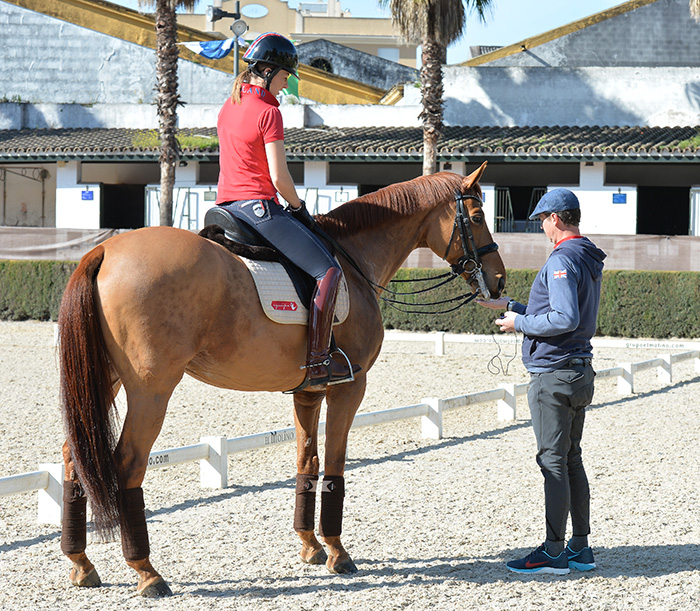
Since we are living in an epoch in which the mechanics and mechanisation reign supreme, some people seem to forget that the horse is a living being, which we should respect as such. There are members of the veterinary profession who disgrace it by forgetting that their first concern should be the well-being of the horse and not the ambition or pocketbook of the rider or owner. No veterinarian should act like the pit crew at a motor race. If the car has mechanical trouble, the drive pulls into the pits, the mechanics do their job, push the car back on the track and off the driver goes again. A real horseman knows his horse and feels what can be asked of him.
Marit Kretschmar in Pferd und Reiter im Orient (1980) found that in at least two Turkish epics it was stressed that a commander who broke off a battle because the horses were too tired to go on was praised. While two other people were frowned upon, of these two, one, who had lost his son during a hunt, had kept his horse going during the night in searching for his son and the other had ridden three days and three nights to save his brother. The ethical relationship between man and horse was very strong with the Turks.
Times have changed and man is not dependent on horses any more; but this does not mean that we should forget the supreme qualities of this extraordinary living being. The horse is by nature a gentle, non-aggressive animal, only too willing to cooperate, provided however that he is treated with gentleness and firmness. If you treat him as a motorcycle you are in for trouble.
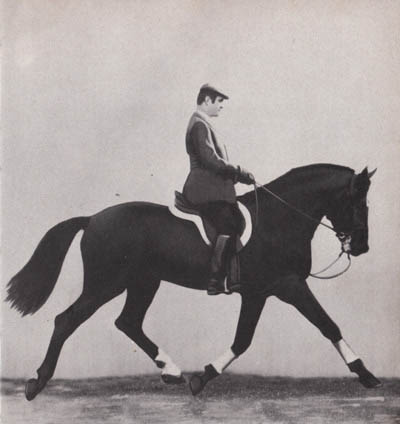
Jeanne Boisseau, in Notes sur l’enseignement de Nuno Oliveira(1979) quotes a maxim of Oliveira’s: ‘If the horse is happy, everything will be all right; if he is constrained everything will go wrong. And in case that it is necessary to use force, then one enters a domain that does not fit the equestrian art, neither for that matter, in the circle in which civilised people dwell’.
I urge my readers to apply the aids to help the horse, not to put him in a mould.

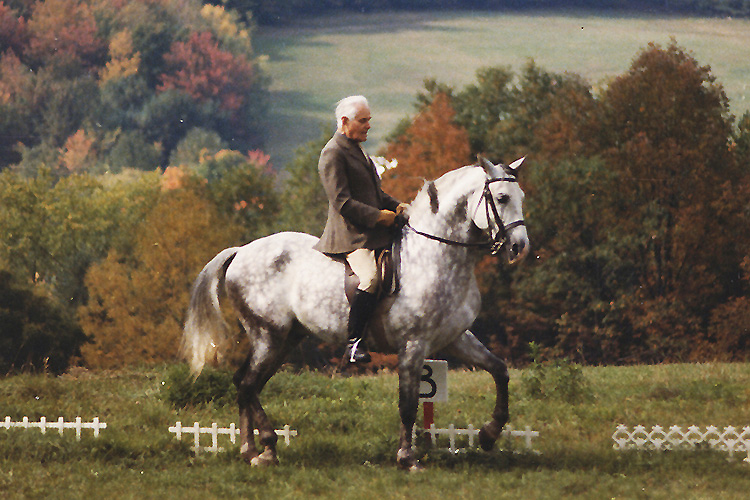
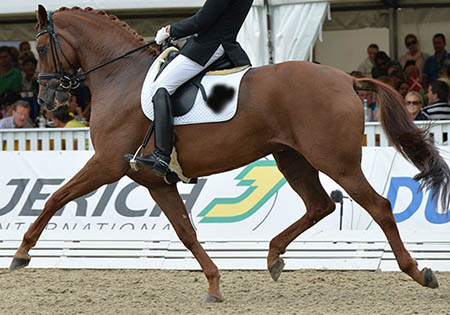
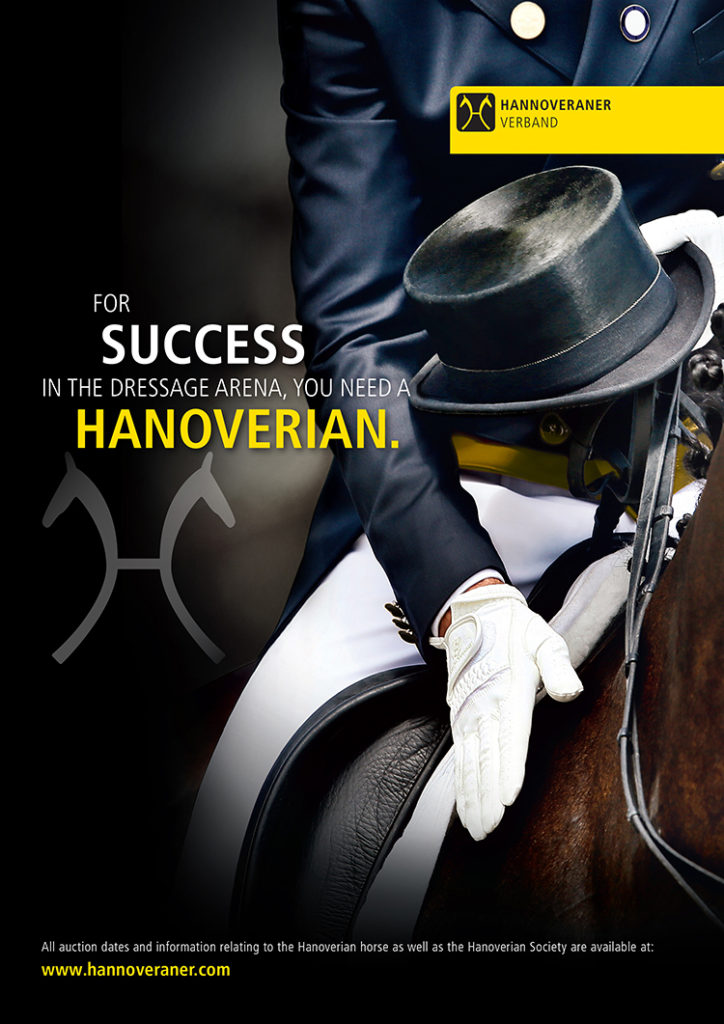
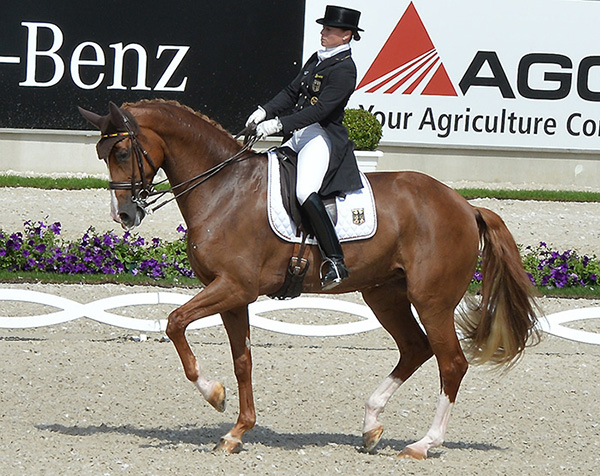
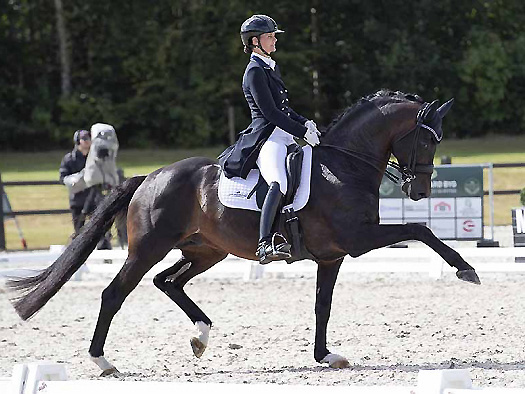
Well explained. Thank you 😊